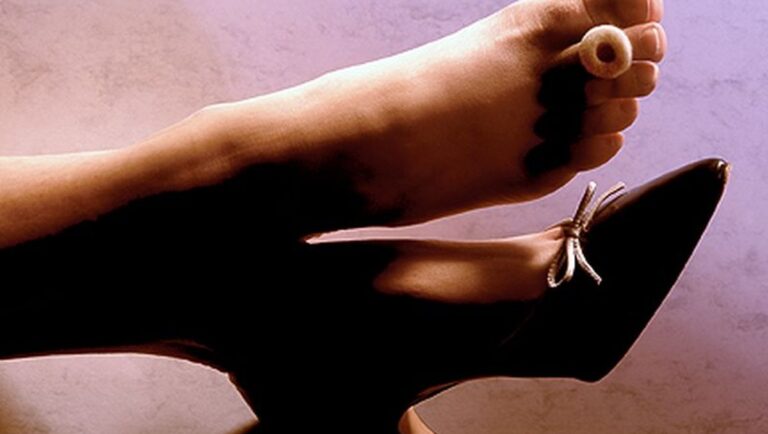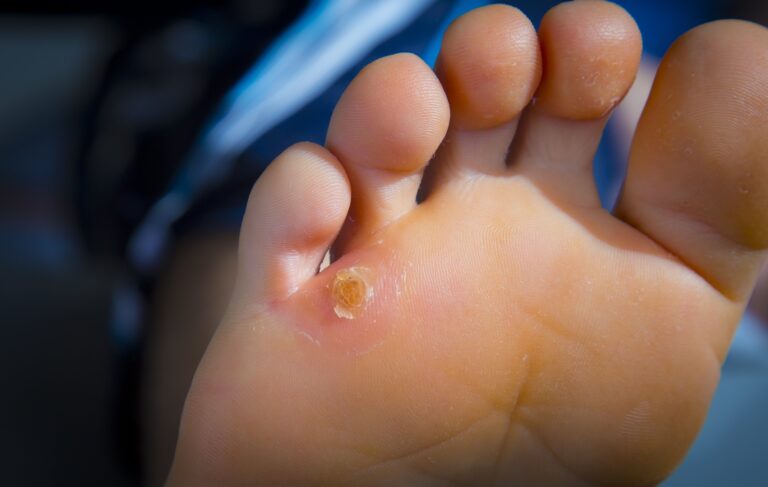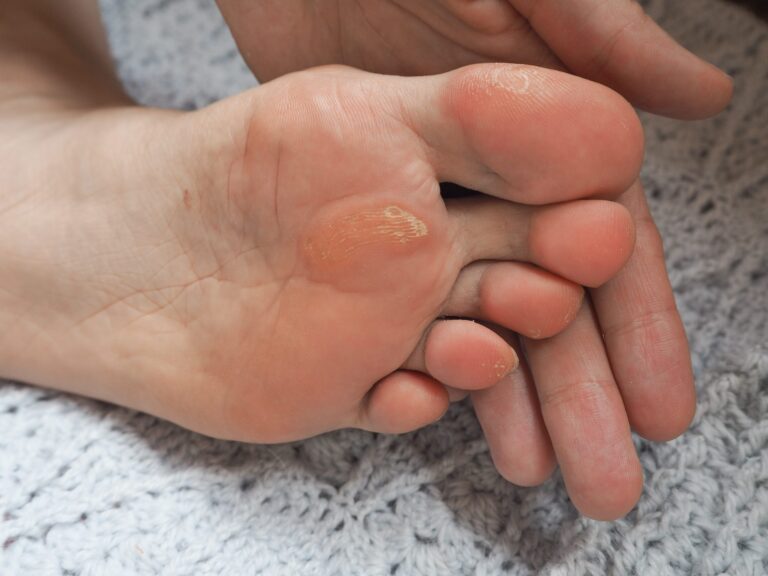Calluses and corn develop due to friction in the feet. They can be unpleasant to look at and usually feel quite painful! Corns and calluses can occur anywhere on the foot on the location that is constantly rubbing or irritate.
Calluses and corns are skin changes that result from repetitive trauma to the skin of our feet. The skin changes when placed under mechanical stress from your everyday activities such as standing for a long duration, walking, and running.

WHAT IS CORN?
Foot corns appear as hardened layers of skin. These develop from your skin’s response to friction and pressure from daily activities. Foot corns appear mostly on the tips and the sides of your toes with symptoms such as:
- Rough, tough, yellowing patch of lumpy or bumpy skin
- Skin sensitive to touch
- Pain while wearing shoes

Corns develop as hard and soft such as:
- Hard corns: These occur on the top of the smaller toes or the outer side of the little toe. These are formed where poorly fitted shoes tend to rub most making the skin of that area hard.
- Soft corns: These are formed between the toes, most commonly between the fourth and fifth toes. These corns are soft due to the sweat between the toes that keep them moist. Soft corns can sometimes become infected.
They are sometimes painful as foot corn’s press into the deeper layers of skin. Foot corns can be safely treated, and you can even prevent future ones.
Foot corn usually develops from wearing shoes that are too snug on your feet. The weight of your body if you stand or walk for long periods, and the constant friction can also cause painful corns on the bottoms of your feet.
WHAT ARE FEET CALLUSES?
A callus usually appears larger and broader than corn with a less well-defined edge. These tend to form on the underside of your foot (the sole). Calluses commonly develop over the bony area just underneath your toes. This area underneath the toes is a weight-bearing area that takes much of your weight while walking.
Many people confuse calluses with a skin problem, but they are systemic of a problem with the bone. Calluses are accompanied by painful nerves and bursal sacs (fluid-filled balloons that act as shock absorbers) beneath them. These would cause symptoms ranging from sharp, shooting pain to dull, aching soreness.
Sometimes, calluses get thickened and are not treated. This can lead to cracks, mainly around your heels as it is more prone to develop cracks or fissures in the skin and it can be very painful.
WHAT IS THE CAUSE OF CORNS AND CALLUSES?
The bones comprising the toes and feet are broader as well as lumpy near to the joints of the toes. The repeated friction or pressure on the skin that is overlying a small rough area of bone will cause the skin to thicken leading to callus formation.
The rubbing and pressure are commonly caused by tight or ill-fitting shoes, which causes corns on the top of the toes as well as on side of the little toe. Long duration of walking or running tends to cause calluses on the bottom of the feet or the soles.
Mechanical stress that involves repeated pressure on your feet will increase your risk of developing corns and callus. These would include:
- Poor-fitting footwear: Poor-fitting shoes exert higher pressure on a small area such as a joint. It is more common among women due to tight-fitting heels to form calluses and corns over the little toes and balls of the feet. The way you walk puts abnormal pressure distribution on your foot resulting in callus formation along with areas such as the heel and the ball of the big toe.
- Bony prominences: These result in the formation of bunions or hammertoes.
- Advancing age: this is mostly caused as the protective fat pad of the feet is lost with age.

Corns and calluses are likely to develop due to prominent bony toes, thin skin, or any deformities of the toes or feet. This results in the skin rubbing more easily inside shoes. People suffering from bunions are more likely to develop corns and calluses as the bump would rub against the footwear.
HOW TO TREAT CORNS AND CALLUSES?
You might not require any treatment if a corn or callus isn’t bothering you. To treat the corns as well as calluses it is important to identify the cause of the corn or callus. Podiatrists would advise treatments option such as corn plasters. These would help reduce the pressure on your corn but it will not treat the corn.
Various options and advice to treat corns and calluses include:
- Trimming or paring down: A podiatrist would pare the thickened skin of a corn or callus by using a scalpel blade. This reduces the pain as the corn or callus is pared down and the pressure on the underlying tissues eased. In case, the skin seems to be thickening up again, a recurrence may be prevented. Rubbing down the thickening skin again with a pumice stone or emery paper once a week will prevent the thickening of the skin. A moisturizing cream applied to the affected area regularly will keep the skin softened and easier to rub down.
- Chemical Treatment: The thickened skin can be chemically pared-down along with dead skin on corns and calluses. Chemical treatment usually comprises salicylic acid that dissolves the protein-making the corn and the thick layer of dead skin that tops it. This will turn the top of your skin white, which will allow you to trim or peel away the dead tissue. This trims the corn sticking out, which will make it less painful. Salicylic acid treatments are available in various forms such as drops, pads, and plasters.
- Shoes and Footwear: It is believed that tight or ill-fitting shoes cause most corns and calluses. Sometimes, a rough seam or stitching may rub enough to cause corn. The podiatrist focuses on reducing the pressure and rubbing on the toes and forefeet due to your footwear. It is advised that shoes should have space for the toes and have soft uppers and low heels. High heels, especially tight-fitting shoes, can lead to repeated friction and forces corns and calluses to worsen.
- Footpads and toe protection: A cushioning pad or shoe insole is required depending on the site of a corn or callus. A special toe splint helps to keep the toes apart to allow corn between toes to heal. A podiatrist will advise any appropriate padding, insoles, or appliances you may need.
- Surgery: Surgery is required for foot or toe abnormality causing recurring problems. An operation helps straighten a deformed toe, or to cut out a part of a bone that is sticking out from a toe and causing problems.
TAKEAWAY
The corns or calluses can become infected, especially those suffering from diabetes. Your corn and calluses would become more painful. The skin around the corn or callus will become red and sore, leading to the formation of pus. Medication is prescribed to treat the infection.
If you or anyone you know is suffering from foot problems, our expert providers at Specialty Care Clinics will take care of your health and help you recover.
Call us on (469) 545-9983 to book an appointment with our specialists.
